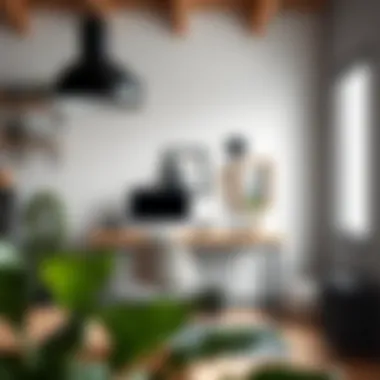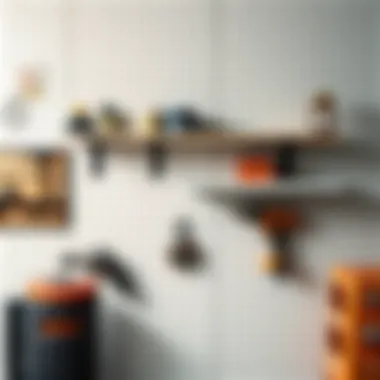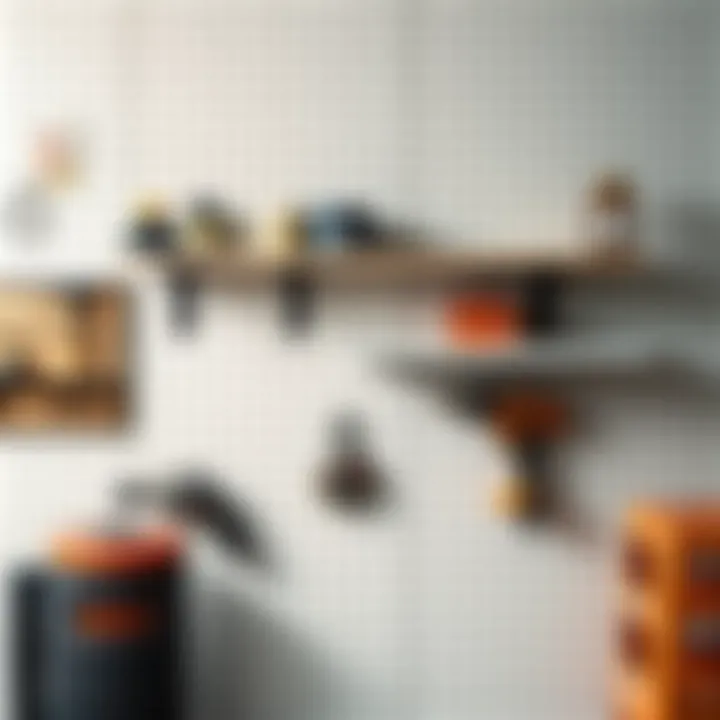Exploring Pegboard Materials: A Complete Guide


Intro
The world of pegboard materials often flies under the radar, yet it stands as a cornerstone for countless organizational solutions in homes, workshops, and creative spaces. From tool storage to creative displays, pegboard provides ample versatility. By understanding its origins, varieties, and applications, individuals can harness its potential in ways that are both functional and aesthetically pleasing.
Pegboard's journey began in the mid-20th century, mainly as a tool organizer in garages, but it has since evolved. Today, people are using pegboard not only to store but also to decorate and personalize their environments. Whether you're looking to declutter a workspace or add a design element to your residence, pegboard materials offer benefits that can't be ignored.
Key Takeaways
- Origins: Uncover the historical evolution of pegboard.
- Versatile Applications: Learn how pegboards can serve both practical and decorative functions.
- Choosing the Right Material: Compare various types of pegboard materials.
- Installation and Maintenance: Tips for ensuring longevity and maintaining aesthetic appeal.
For homeowners, designers, and DIY enthusiasts alike, understanding the nuances of pegboard materials can open avenues for creativity and efficiency. Let’s dive deeper into the design trends that are currently shaping how pegboards are used to maximize their impact in modern spaces.
Understanding Pegboard Material
Understanding pegboard material is paramount for homeowners, designers, and DIY enthusiasts alike. This seemingly simple board, dotted with holes for hooks and shelves, is a versatile tool that can transform disorganization into functionality. The central role of pegboards is not just to hang tools or decor; they serve multiple purposes depending on the material they’re made from and the way in which they are utilized. Each type of pegboard brings its own unique benefits, suitability for different settings, and aesthetic appeal to the table.
History and Evolution of Pegboard
The use of pegboards can be traced back to the era when people sought more efficient means to store tools and materials. Initially, wooden boards were crafted with pre-drilled holes to facilitate better organization, which revolutionized spaces like workshops and garages. Over the years, as lifestyles became more dynamic, so did the pegboard. Innovations in materials led to the introduction of metal and plastic boards, each expanding the possibilities for customization and functionality. Today, pegboards are not only functional but have also found a place in modern decor, with colors and finishes that blend seamlessly into home and office interiors.
Types of Pegboard Materials
There are three main types of pegboard materials on the market today: wooden, metal, and plastic. Each brings its own flavor of functionality and style, appealing to various needs and environments.
Wooden Pegboard
Wooden pegboards carry an charm that's hard to replicate. Their warm tones can complement a wide range of designs, from rustic to modern. The robust construction of wooden boards provides durability that can support heavy items, making it a favored choice for zealous DIYers and particular homeowners. Moreover, they can be easily stained or painted to match one’s decor. However, a downside to wooden pegboards is their susceptibility to warping over time and in humid conditions. As long as one takes care in their upkeep, though, wooden pegboards can serve for many years, proving to be a wise investment.
Metal Pegboard
Metal pegboards shine in the strength department. Made from steel or aluminum, they can handle significantly heavier loads, allowing for tools and equipment to be suspended without fear of failure. Their sleek, industrial appearance fits well in contemporary garages or workshops. They can also resist environmental factors like moisture and rust, extending their lifespan. Yet, their cold feel and limited color options may not appeal to all designers or homeowners looking for aesthetic versatility. Metal pegboards can often be pricier, but they provide assurance in durability and performance.
Plastic Pegboard
Plastic pegboards offer a fun twist on traditional pegboards. Lightweight and highly customizable, they often come in a variety of vibrant colors, attracting DIY enthusiasts looking for an affordable way to beautify and organize their spaces. They are resistant to moisture, making them ideal for kitchens or laundry rooms, areas where water may come into play. However, one must be cognizant of the weight limits; while they are excellent for lighter items, plastic pegboards may buckle under substantial weight. This makes them a great choice for crafty projects but less suitable for holding heavy tools.
Advantages of Using Pegboard
When it comes to organizing and displaying tools or decor, pegboards are a game changer. They are not just a simple storage solution; they have unique characteristics that make them stand out, allowing for versatility that you won't find in many conventional options. This section dives into the key benefits of pegboard, emphasizing elements that make this material an essential in homes and workplaces alike.
Versatility and Customization
One of the most significant advantages of pegboard is its versatility. You can use pegboards in any space, adapting them to fit various needs. Whether you're looking to create a tool wall in your garage, organize spices in the kitchen, or even showcase art supplies in a craft room, pegboard can do it. Because it comes in a variety of materials—wood, metal, plastic—the look can be tailored to the aesthetic of the room.
The customization options are nearly limitless. You can paint pegboard to match your wall or decor. With a little creativity, you can add hooks, baskets, and shelves to hold everything from gardening tools to craft items. This adaptability allows homeowners and DIYers to take control of their space in a way that pre-made shelving simply cannot offer.
"Pegboard projects often take on a life of their own, driven by the needs and imagination of their creators."
Moreover, the installation process is fairly straightforward. This means homeowners can easily change layouts without heavy construction, making it an excellent solution for renters or those who love to switch things up often. Using pegboard not only supports functional organization but also encourages personal expression through design.
Space Optimization
Now, let’s address the issue of space—a real concern in many households. Many people live with limited space, making it crucial to utilize every inch wisely. Pegboard shines in this aspect. Since it hangs on the wall, it frees up floor space and can turn blank walls into functional storage areas ripe with potential.


In small kitchens, for instance, a pegboard may hold pots and pans or even utensils, rendering kitchen counters clutter-free. In busy home offices, you can manage craft supplies or paperwork neatly on the walls instead of resulting in massive clutter. This not only creates an aesthetically pleasing environment but also boosts productivity.
3D space can be maximized vertically, meaning you can store more with less. Here are some ways pegboard helps in optimizing space:
- Vertical Storage: Utilizing wall space instead of floor space; particularly beneficial in compact areas.
- Easy Access: Frequently used items stay at eye level, saving time when you need to grab something quickly.
- Adaptable Layouts: Changing demands can be met through rearranging items without significant effort or expense.
Comparing Pegboard with Alternative Solutions
When deciding on storage solutions, comparing pegboard with alternative options is essential. Pegboard systems are gaining traction due to their adaptability and ease of use, yet various other solutions exist, each with its own merits and drawbacks. This section aims to illuminate the contrasts and consider what matters most to homeowners, designers, and DIY enthusiasts. After all, choice often comes down to personal needs and the specific context in which the materials will be used.
Shelving Units
Shelving units offer a traditional, yet highly effective method for organizing a space. They can hold a hefty amount of weight and are often built to be quite sturdy. One perk of shelving units is their permanence. When you affix them to the wall or place them on the floor, you generally set them and forget them. However, there are conundrums that come with them — for example, they can limit accessibility. If you're at a service station or have equipment that you need regularly, it might be inconvenient to keep going to the higher shelves.
Moreover, if you need to alter the layout of the room, you might have to exert some effort to uninstall and reposition them, which is more complex than simply moving things off a pegboard.
Wall-Mounted Storage
Wall-mounted storage solutions come in a myriad of shapes and sizes. Think of hooks, brackets, and gun racks. They excel at maximizing vertical space. However, their utility decreases in environments where various tools or items of different sizes are stored. Unlike pegboards, which allow for the flexibility of reconfiguring items, wall-mounted solutions may demand more commitment and oftentimes lack the capacity to adjust on the fly.
In smaller spaces, wall-mounted storage may also lead to a cluttered appearance if not organized well. The ease of rearranging items on a pegboard grants users the versatility missing in traditional wall-mounted systems. Therefore, for spaces requiring constant change, pegboards might take the cake.
Cabinet Systems
Cabinet systems offer a neat and clean way to store items out of sight, providing an aesthetically pleasing ambiance to whichever room they inhabit. The closed nature of cabinets can be a blessing for keeping dust at bay or simply ensuring that belongings don’t become visible clutter. However, that privacy comes at the cost of accessibility.
If the goal is quick access to tools and supplies, a cabinet may not serve well. Opening and closing doors can lead to time wasted rummaging around, especially if they are stuffed full of tools. In contrast, pegboards line up items at eye level, allowing quick identification and access.
Ultimately, every storage solution has its strengths and weaknesses.
Each option can cater to different scenarios and preferences, but how you weigh those variables may clarify your path forward. By understanding what pegboard brings to the table compared to shelving units, wall-mounted storage, and cabinet systems, you can make an informed choice that aligns with your goals.
Choosing the Right Pegboard Material
When it comes to harnessing the full potential of pegboard for storage and organization, selecting the right material is a crucial first step. This choice not only affects the aesthetics but also the performance and longevity of the pegboard itself. With so many options on the market, the right material can prevent headaches down the line, ensuring that the pegboard can withstand both the weight of tools or decor and the test of time. Here, we will examine key considerations that can make the difference between a successful installation and a disappointing one.
Considerations for Material Selection
Weight Capacity
The weight capacity of a pegboard is a critical aspect when making your selection. It refers to the maximum load a pegboard can bear without bending or breaking. Choosing a board with adequate weight capacity ensures that your heavier items have a safe place to hang without the worry of them falling.
In practice, wooden pegboards tend to have a higher weight capacity compared to their plastic counterparts. This makes them an excellent choice for garage settings where tools weigh significantly more than kitchen items. It's essential to consider the specific needs of your space; heavier tools require a sturdier base, making weight capacity a key characteristic for the discerning user.
The unique feature of weight capacity is its direct relation to the types of screws and anchors used. Using appropriate hardware can enhance the board’s load-bearing ability, thus expanding its practical applications. However, keep in mind that overloading the pegboard can still lead to damage, which can be a drawback in some instances.
Durability
Durability in pegboard materials goes hand-in-hand with how long you can expect your installation to last. Materials differ significantly in their resilience to wear and tear. Metal pegboards, for example, are known for their strength and longevity, making them suitable for both commercial and home use. Conversely, plastic pegboards, while lightweight and easy to install, often show wear more quickly.
The key characteristic here is that a durable pegboard can withstand exposure to harsh environments, like humid garages or wet kitchens, without failing. They resist warping or scratching, which means they stay looking sharp longer. Additionally, some pegboards even come with a coating that makes them resistant to chemicals, adding a layer of protection that might be necessary in a workshop setting.
A potential drawback to high-durability materials is often their cost. It can be tempting to cut corners if on a tight budget, however, investing in a durable board can save money in the long run, eliminating frequent replacements.
Cost Efficiency


Cost efficiency is not just about the initial price tag; it's also about how much value you get from your pegboard over its lifespan. Some people might opt for the cheapest option upfront, but that could lead to increased expenses later through frequent replacements. The balance between quality and affordability can be tricky but is crucial for any savvy consumer.
A cost-efficient pegboard choice often means looking beyond the surface. For instance, investing in a slightly more expensive but durable metal pegboard can yield savings on installation and maintenance over time. Moreover, consider the versatility of the pegboard for different uses; a well-chosen board could even work well in multiple areas of your home, enhancing value through its adaptability.
There’s also the possibility of future-proofing your pegboard by considering additional accessories, racks, or hooks that might be comfortably supported. This foresight can minimize future costs related to changing your setup.
Design Aesthetics
Design aesthetics play a pivotal role in the choice of pegboard material. Beyond its functional capabilities, the look of the pegboard should match the character of the space where it is installed. For a modern kitchen, sleek metal pegboards might work wonders, while rustic wooden boards can bring warmth to a traditional farmhouse style.
It’s equally significant to consider the color and finish of the pegboard. Some materials can easily be painted or stained, offering opportunities for customization that enhances the room. Choosing the right pegboard material allows homeowners not only to optimize storage but also to contribute meaningfully to their decor.
By weighing these considerations—weight capacity, durability, cost efficiency, and design aesthetics—homeowners, designers, and DIY enthusiasts alike can find the perfect pegboard material that aligns with their specific needs and preferences.
"The right pegboard is more than just a utility; it's an aesthetic choice that can transform a space into something functional and beautiful."
Once all these factors are considered, you're well on your way to making an informed decision that serves both the practical and decorative needs of your home.
For further resources on pegboard materials and DIY installations, you may find the following links beneficial: Wikipedia on Pegboard, Britannica on Storage Solutions.
Installation Techniques
Understanding how to properly install pegboard is crucial for optimizing its functionality and appearance. This section provides a deep dive into the installation techniques that will help you to explore the full potential of your pegboard system. When done right, an installation elevates its use from merely a practical solution to a professional-looking exhibit in your space.
Why Installation Matters
Getting the installation process correct cannot be overstated. It directly impacts the stability of your stored items, the aesthetics of your workspace, and even your overall safety while using the pegboard. Using the right techniques ensures that the pegboard is securely fastened and that it can bear the weight of all the items you intend to hang. Moreover, a well-installed pegboard contributes to a visually appealing ambiance by aligning with the décor of your home or workspace.
Tools Required for Installation
When gearing up for a pegboard installation, having the right tools at hand makes a world of difference. Here’s a list of tools and materials you'll need:
- Drill: A standard power drill will be essential for making holes in the wall or for fastening screws.
- Screws and Wall Anchors: Be sure to choose quality screws and wall anchors that match the weight capacity of your pegboard.
- Level: A level is vital for ensuring that your pegboard hangs straight. An uneven pegboard can lead to a chaotic look and could cause things to slide off or fall.
- Tape Measure: This handy tool will help you measure and mark where the pegboard will go beforehand.
- Utility Knife: Useful if adjustments are needed on the pegboard itself.
- Pencil: For marking precise points where holes should be drilled or the pegboard should be placed.
- Safety Gear: Safety glasses and gloves should be worn during installation as a precautionary measure.
Step-by-Step Installation Process
Installing pegboard might seem daunting, but it can be straightforward if you follow these steps:
- Choose Your Location: First, decide where you want the pegboard to be installed. Make sure it’s a convenient spot.
- Mark the Area: Using a tape measure and pencil, outline the dimensions of your pegboard on the wall.
- Drill Holes: Based on your markings, drill holes into the wall where screws or anchors will go. Be certain to drill into studs whenever possible for maximum support.
- Insert Wall Anchors: If not drilling into studs, place wall anchors into the drilled holes. This will grip the pegboard and keep it stable.
- Attach the Pegboard: Align the pegboard with your drilled holes and use screws to attach it securely to the wall. Make sure it’s level before tightening.
- Double-Check Stability: Gently pull at the edges of the board to ensure it’s fastened securely. Any movement may necessitate a tighter installation.
- Finish Off: Once secured, take a step back and admire your work. Now you can hang hooks and accessories as needed.
"A well-planned installation leads to a beautifully arranged space that highlights both functionality and style."
With these tools and step-by-step instructions, you are ready to embark on your pegboard installation journey. Whether it’s a cluttered garage or a stylish home office, getting the installation right sets the stage for a seamlessly organized backdrop.
Maintenance of Pegboard Material
Taking care of your pegboard is essential for ensuring its longevity and functionality. Maintenance may not be the first thing that comes to mind when you install a pegboard, but it can play a vital role in how well it serves your storage needs. Regular upkeep not only retains the aesthetic appeal but also promotes safety and efficiency in your workspace or home. Let’s dive into the specifics.
Cleaning Recommendations
Maintaining a clean pegboard involves a little elbow grease but pays dividends in the long run. Here are some effective cleaning practices:
- Dust Regularly: Even something as simple as dusting can make a huge difference. Use a microfiber cloth or a soft broom to wipe down the surface periodically to remove dust and debris that can accumulate over time.
- Spot Clean Stains: If you spill something on your pegboard, addressing it right away is key. A damp cloth with a mild soap solution can usually do the trick for most stains. Be sure to avoid abrasive cleaners that could scratch the surface.
- Inspect and Tighten Hardware: If your pegboard seems like it's sagging or the hooks are loose, it might be time for a small inspection. Just check the screws, anchors, or brackets every now and again. Tightening them can improve both safety and appearance.
- Prevent Moisture Accumulation: For wooden pegboards especially, moisture can be a real culprit. If your pegboard is in an area prone to humidity, consider applying a sealant or varnish to protect it. For metal pegboards, ensure they are positioned in well-ventilated areas to deter rust.
As you keep your pegboard clean, remember that a little attention can go a long way. It’s all about keeping it looking sharp and functional.


Long-Term Care
To extend the life of your pegboard material beyond just a quick clean-up, long-term care considerations are necessary. Here are some points to keep in mind:
- Seasonal Maintenance: With changes in temperature and humidity throughout the year, seasonal checks on your pegboard can prevent future issues. For instance, spring cleaning can include making sure all the fasteners are still in good shape.
- Rearranging Tools: Over time, you may find it beneficial to rearrange your tools or other items on your pegboard. This not only keeps things fresh visually but also helps distribute weight evenly, reducing wear and tear on localized areas.
- Update Hardware: Hooks and accessories sometimes need to be replaced or upgraded as your storage needs evolve. Choosing durable hardware will not only improve functionality but may also enhance the overall look of the pegboard setup.
- Monitor for Damage: Routine inspections for cracks or warping, especially in wooden materials, will allow you to take action before minor issues escalate. Replacing any damaged sections promptly can save you money and hassle down the line.
Taking proactive steps in both cleaning and long-term care ensures that your pegboard remains not just a functional storage solution, but also a visually pleasing part of your space.
"A pegboard that’s well-maintained is like a well-tuned engine—smooth, efficient, and ready to perform."
For more in-depth maintenance tips, visit Hometips.
Further resources can also be found at Wikipedia.
Keep your pegboard thriving, and it will, in turn, keep your environment organized and efficient.
Creative Uses for Pegboard
Pegboard isn’t just a tool; it’s a canvas where creativity meets practicality. This section dives into how pegboard can amplify functionality across various settings. It showcases its benefits, from enhancing organization to adding a personal touch to your spaces. The versatility of pegboard makes it suitable for any homeowner, designer, or DIY enthusiast, presenting an opportunity to innovate beyond traditional storage solutions.
In Home Offices
A home office can quickly become cluttered if not managed well. Using pegboard allows for effective organization of essential items. Imagine hanging not just tools and documents but also art pieces or motivational quotes that inspire productivity. By using colorful hooks and shelves, pegboard can reflect personal style while optimizing desk space.
- Visual Appeal: Customizing a pegboard with paint or unique shapes can turn functional storage into a design element.
- Adaptability: Easily rearranging items on pegboard keeps the workspace fresh and responsive to ongoing needs.
In Kitchens
The kitchen is the heart of any home. Make it more efficient and pleasing with pegboard. Hang utensils, pots, and even spices for easy access. A pegboard can reclaim valuable counter space while adding a rustic charm that many seek. Here are a few ideas:
- Herb Drying Rack: Hang bundles of herbs on a pegboard adorned with hooks for a simple yet functional drying solution.
- Unique Kitchen Organization: Use pegboard to display mugs, mixing bowls, and even cookbooks, providing both accessibility and aesthetic appeal while decluttering.
In Garages and Workshops
Garages and workshops can often resemble chaotic mazes of tools and supplies. Enter pegboard, which can lend both order and efficiency to these spaces. Tools can be hung securely in sight, reducing the time spent searching. Consider these benefits:
- Categorization: Designate sections for specific types of tools—hand tools on one side, power tools on another—streamlining access.
- Enhanced Safety: Tools placed on a pegboard minimize the risk of accidents caused by misplaced items.
Quote: "Pegboard transforms spaces, making them functional pathways to creativity and efficiency."
In summary, the applications of pegboard are limited only by one’s imagination. Whether in a home office, kitchen, or garage, this material serves multiple purposes, turning chaos into charm and inefficiency into ease. As more people look for innovative solutions to everyday problems, pegboard's versatility positions it as a go-to choice for storage and design.
Future Trends in Pegboard Material
As we look ahead, the evolution of pegboard materials reflects broader trends in sustainability and technology. This section delves into what's on the horizon for pegboard systems, revealing innovations that go beyond mere functionality, making them not only smarter but also eco-friendlier. The importance of these elements cannot be overstated, especially as consumers are increasingly conscious of their impact on the planet and the benefits of integrating modern technology into their living and working spaces.
Sustainable Materials
The push for sustainability is reshaping many industries, and pegboard materials are no exception. More manufacturers are investigating eco-friendly options, such as recycled woods and biodegradable plastics. Here are some trends in sustainable materials that are slowly but surely coming to light:
- Recycled Wood Products: Some companies are taking wasted lumber from construction projects and repurposing it into pegboard. The result? A product that not only retains its strength but also tells a story of regeneration and resourcefulness.
- Bamboo Pegboard: Fast-growing bamboo is becoming a popular choice due to its strength and renewability. Unlike traditional hardwoods, bamboo reaches maturity in just a few years.
- Biodegradable Plastics: Advances in bioplastics mean pegboards made from materials that break down easier than conventional plastics. These options reduce landfill waste and lessen the overall environmental impact.
The shift to sustainable materials in pegboards holds great significance for a diverse audience. For homeowners landscapers, it provides an eco-friendly choice that aligns with a green lifestyle. Designers can also incorporate these modern materials into their projects, enhancing aesthetic appeal while being mindful of Mother Earth.
"Incorporating sustainable materials is not just a trend; it’s a necessary step towards responsible living in today’s world."
Smart Pegboard Solutions
Smart technology is permeating even the most traditional of home and workspace solutions, and pegboards are being infused with innovation. Imagine a pegboard that not only organizes your tools but also interacts with you through your smartphone or a smart home device. Here’s a glimpse of what’s to come:
- Integrated Sensors: Future pegboards may include sensors that detect when tools are removed or replaced, sending alerts to your smartphone about misplaced items or helping to monitor inventory.
- Modular Designs with Smart Features: Picture modular pegboard systems that come with built-in charging ports or lighting. These will allow you to customize your workspace without sacrificing functionality.
- AI-Driven Organization Apps: Some pegboard systems are now designed to work in tandem with mobile apps. These apps can suggest optimal layouts based on the tools and items you frequently use. This feature makes organizing as easy as pie!
The emergence of smart pegboard solutions caters to tech-savvy individuals and DIY enthusiasts looking for efficiency and ease in organization. It combines practical storage with high-tech benefits, illuminating the path ahead in functional design.















